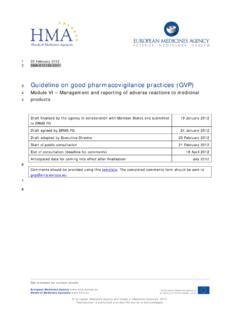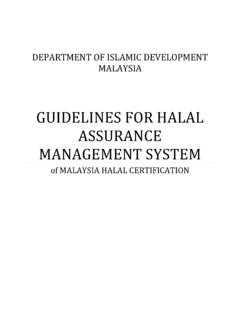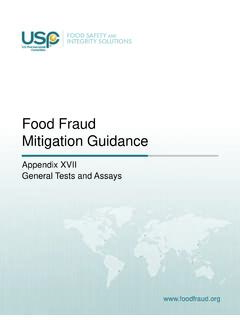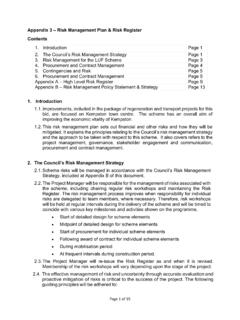Transcription of 2013 NCHS Urban–Rural 2014 Classification Scheme for …
1 2013 NCHS Urban Rural Classification Scheme for Counties Series 2, Number 166 April 2014 Copyright information All material appearing in this report is in the public domain and may be reproduced or copied without permission; citation as to source, however, is appreciated. Suggested citation Ingram DD, Franco SJ. 2013 NCHS urban rural Classification Scheme for counties. National Center for Health Statistics. Vital Health Stat 2(166). 2014. Library of Congress Catalog Number 273 dc23 For sale by the Government Printing Office Superintendent of Documents Mail Stop: SSOP Washington, DC 20402 9328 Printed on acid-free paper. Series 2, Number 166 2013 NCHS Urban Rural Classification Scheme for Counties Data Evaluation and Methods Research DEPARTMENT OF HEALTH AND HUMAN SERVICES Centers for Disease Control and Prevention National Center for Health Statistics Hyattsville, Maryland April 2014 DHHS Publication No.
2 2014 1366 National Center for Health Statistics Charles J. Rothwell, , , Director Jennifer H. Madans, , Associate Director for Science Office of Analysis and Epidemiology Irma E. Arispe, , Director Contents Acknowledgments .. iv Abstract .. 1 Introduction .. 1 2013 NCHS Urban Rural Classification Scheme for Counties .. 2 2010 OMB Metropolitan Nonmetropolitan Classification of Counties .. 2 County Urbanization Levels Defined .. 2 Assignment of Counties to the Six Levels of the 2013 NCHS 2 Changes in County Urbanization Category: Comparing 2013 and 2006 schemes .. 4 Health Measures by Urbanization Level .. 5 Considerations When Analyzing Trends Using Urbanization Classification 6 Summary .. 6 References .. 7 Appendix I.
3 Assignment of Large Metropolitan Counties .. 12 Appendix II. List of Counties and County-equivalent Entities and Their Urbanization-level 25 List of Detailed Tables 1. Categories and Classification rules of the 2013 NCHS Urban Rural Classification Scheme for Counties .. 8 2. Number of counties and percentage of the population in each urbanization level of the 2013 and 2006 NCHS Urban Rural Classification schemes for Counties .. 8 3. Median for selected county characteristics, by urbanization level: 2013 NCHS Urban Rural Classification Scheme for Counties .. 9 4. Classification of counties according to the 2013 and 2006 NCHS Urban Rural Classification schemes for Counties .. 9 5. Age-adjusted death rates for all causes, by age, sex, and NCHS Urban Rural Classification Scheme for Counties: United States, average annual 2008 2010.
4 10 6. Age-adjusted death rates for selected causes, by sex and NCHS Urban Rural Classification Scheme for Counties: United States, average annual 2008 2010 .. 11 7. Selected health measures for persons aged 18 64, by NCHS Urban Rural Classification Scheme for Counties: National Health Interview Survey, 2010 2012 .. 11 List of Appendix Tables I. Comparison of Classification rule and discriminant model assignments of large metro counties to large central and large fringe metro categories: 2013 NCHS Urban Rural Classification Scheme for Counties .. 12 II. Classification rule and discriminant model assignments of the large metro counties and county-equivalent entities with discordant assignments and their final assignments: 2013 and 2006 NCHS Urban Rural Classification schemes for Counties.
5 13 III. First quartile, median, and third quartile of selected characteristics of large central and large fringe metro counties: 2013 NCHS Urban Rural Classification Scheme for Counties .. 14 IV. Counties in large metropolitan statistical areas (1 million or more population) and their 2013 and 2006 NCHS Urban Rural Classification Scheme assignments, by February 2013 Office of Management and Budget-designated metropolitan statistical area .. 15 V. List of counties and county-equivalent entities and their urbanization levels: 2013, 2006, and 1990 census-based NCHS Urban Rural Classification Scheme for Counties .. 26 iii Acknowledgments The authors gratefully acknowledge the contributions made by Jeffrey Pearcy who created the map of the 2013 NCHS Urban Rural Classification Scheme for Counties and Shilpa Bengeri who did the computer programming for the National Health Interview Survey data examples.
6 The authors also gratefully acknowledge the assistance of the following people at NCHS who reviewed this report: Jeffrey Berko, Jennifer D. Parker, Julia S. Holmes, and Jennifer H. Madans. The report was edited and produced by NCHS Office of Information Services, Information Design and Publishing Staff: Jen Hurlburt edited the report, typesetting was done by Annette F. Holman, and graphics were produced by Sarah Hinkle. iv Objectives This report details development of the 2013 National Center for Health Statistics (NCHS) Urban Rural Classification Scheme for Counties (update of the 2006 NCHS Scheme ) and applies it to health measures to demonstrate urban-rural health differences. Methods The methodology used to construct the 2013 NCHS Scheme was the same as that used for the 2006 NCHS Scheme , but 2010 census-based data were used rather than 2000 census-based data.
7 All counties and county-equivalent entities are assigned to one of six levels (four metropolitan and two nonmetropolitan) based on: 1) their February 2013 Office of Management and Budget designation as metropolitan, micropolitan, or noncore; 2) for metropolitan counties, the population size of the metropolitan statistical area (MSA) to which they belong; and 3) for counties in MSAs of 1 million or more, the location of principal city populations within the MSA. The 2013 and 2006 NCHS schemes were applied to data from the National Vital Statistics System (NVSS) and National Health Interview Survey (NHIS) to illustrate differences in selected health measures by urbanization level and to assess the magnitude of differences between estimates from the two schemes .
8 Results and Conclusions County urban-rural assignments under the 2013 NCHS Scheme are very similar to those under the 2006 NCHS Scheme . Application of the updated Scheme to NVSS and NHIS data demonstrated the continued usefulness of the six categories for assessing and monitoring health differences among communities across the full urbanization spectrum. Residents of large central and large fringe metro counties differed substantially on many health measures, illustrating the importance of continuing to separate these counties. Residents of large fringe metro counties generally fared better than residents of less urban counties. Estimates obtained from the 2013 and 2006 schemes were similar. Keywords: urbanization Scheme metropolitan nonmetropolitan micropolitan 2013 NCHS Urban Rural Classification Scheme for Counties by Deborah D.
9 Ingram, , and Sheila J. Franco, Office of Analysis and Epidemiology Introduction Urban rural differences in health measures have long been recognized. The National Center for Health Statistics (NCHS) Urban Rural Classification Scheme for Counties was developed for use in studying associations between urbanization level of residence and health and for monitoring the health of urban and rural residents. The Scheme groups counties and county-equivalent entities into six urbanization levels (four metropolitan and two nonmetropolitan), on a continuum ranging from most urban to most rural. (Note: In this report, the term counties will be used to refer to counties and county-equivalent entities.) The first NCHS urban rural Scheme , developed in 2001 and referred to as the 1990 census-based NCHS urban rural Scheme , was a six-level Classification Scheme for counties.
10 This Scheme was based on the 1990 Office of Management and Budget (OMB) standards for defining metropolitan statistical areas (MSAs) and on data from the 1990 census. It was updated in 2006 (referred to as the 2006 NCHS Urban Rural Classification Scheme for Counties), following release of MSAs and micropolitan statistical area delineations based on application of the 2000 OMB standards for defining MSAs and micropolitan statistical areas to 2000 census data. A detailed description of the construction of these two schemes is provided in an earlier report (1). Release of 2010 census-based population data, and of MSA and micropolitan statistical area delineations based on the application of the 2010 OMB standards for defining these areas to 2010 census data, prompted this update of the 2006 NCHS Scheme .

















